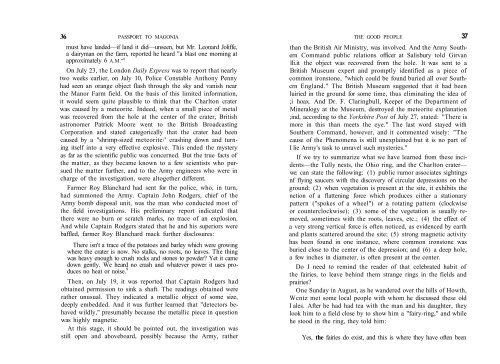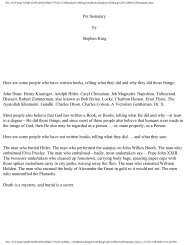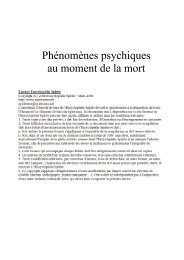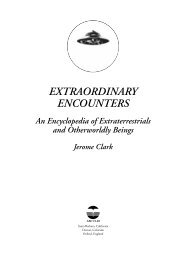Create successful ePaper yourself
Turn your PDF publications into a flip-book with our unique Google optimized e-Paper software.
36 PASSPORT TO MAGONIA<br />
must have landed—if land it did—unseen, but Mr. Leonard Joliffe,<br />
a dairyman on the farm, reported he heard "a blast one morning at<br />
approximately 6 A.M." 8<br />
On July 23, the London Daily Express was to report that nearly<br />
two weeks earlier, on July 10, Police Constable Anthony Penny<br />
had seen an orange object flash through the sky and vanish near<br />
the Manor Farm field. On the basis of this limited information,<br />
it would seem quite plausible to think that the Charlton crater<br />
was caused by a meteorite. Indeed, when a small piece of metal<br />
was recovered from the hole at the center of the crater, British<br />
astronomer Patrick Moore went to the British Broadcasting<br />
Corporation and stated categorically that the crater had been<br />
caused by a "shrimp-sized meteorite/' crashing down and turning<br />
itself into a very effective explosive. This ended the mystery<br />
as far as the scientific public was concerned. But the true facts of<br />
the matter, as they became known to a few scientists who pursued<br />
the matter further, and to the Army engineers who were in<br />
charge of the investigation, were altogether different.<br />
Farmer Roy Blanchard had sent for the police, who, in turn,<br />
had summoned the Army. Captain John Rodgers, chief of the<br />
Army bomb disposal unit, was the man who conducted most of<br />
the field investigations. His preliminary report indicated that<br />
there were no burn or scratch marks, no trace of an explosion.<br />
And while Captain Rodgers stated that he and his superiors were<br />
baffled, farmer Roy Blanchard mack further disclosures:<br />
There isn't a trace of the potatoes and barley which were growing<br />
where the crater is now. No stalks, no roots, no leaves. The thing<br />
was heavy enough to crush rocks and stones to powder? Yet it came<br />
down gently. We heard no crash and whatever power it uses produces<br />
no heat or noise. 9<br />
Then, on July 19, it was reported that Captain Rodgers had<br />
obtained permission to sink a shaft. The readings obtained were<br />
rather <strong>unusual</strong>. They indicated a metallic object of some size,<br />
deeply embedded. And it was further learned that "detectors behaved<br />
wildly," presumably because the metallic piece in question<br />
was highly magnetic.<br />
At this stage, it should be pointed out, the investigation was<br />
still open and aboveboard, possibly because the Army, rather<br />
THE GOOD PEOPLE 37<br />
than the British Air Ministry, was involved. And the Army Southern<br />
Command public relations officer at Salisbury told Girvan<br />
lli.it the object was recovered from the hole. It was sent to a<br />
British Museum expert and promptly identified as a piece of<br />
common ironstone, "which could be found buried all over Southcrn<br />
England." The British Museum <strong>suggested</strong> that it had been<br />
luiried in the ground for some time, thus eliminating the idea of<br />
;i hoax. And Dr. F. Claringbull, Keeper of the Department of<br />
Mineralogy at the Museum, destroyed the meteorite explanation<br />
;ind, according to the Yorkshire Post of July 27, stated: "There is<br />
more in this than meets the eye." The last word stayed with<br />
Southern Command, however, and it commented wisely: "The<br />
cause of the Phenomena is still unexplained but it is no part of<br />
I lie Army's task to unravel such mysteries."<br />
If we try to summarize what we have learned from these incidents—the<br />
Tully nests, the Ohio ring, and the Charlton crater—<br />
we: can state the following: (1) public rumor associates sightings<br />
nf flying saucers with the discovery of circular depressions on the<br />
ground; (2) when vegetation is present at the site, it exhibits the<br />
nction of a flattening force which produces cither a stationary<br />
pattern ("spokes of a wheel") or a rotating pattern (clockwise<br />
or counterclockwise); (3) some of the vegetation is usually removed,<br />
sometimes with the roots, leaves, etc.; (4) the effect of<br />
a very strong vertical force is often noticed, as evidenced by earth<br />
and plants scattered around the site; (5) strong magnetic activity<br />
has been found in one instance, where common ironstone was<br />
buried close to the center of the depression; and (6) a deep hole,<br />
a few inches in diameter, is often present at the center.<br />
Do I need to remind the reader of that celebrated habit of<br />
the fairies, to leave behind them strange rings in the fields and<br />
prairies?<br />
One Sunday in August, as he wandered over the hills of Howth,<br />
Wcntz met some local people with whom he discussed these old<br />
I ales. After he had had tea with the man and his daughter, they<br />
look him to a field close by to show him a "fairy-ring," and while<br />
he stood in the ring, they told him:<br />
Yes, the fairies do exist, and this is where they have often been





